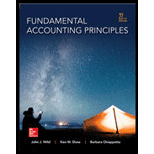
Concept explainers
Introduction:
Product cost: The cost incurred in the production of a product or purchase of products. The product cost is associated with production and the company incurs no production cost if the company has no production or purchase during the specific period. Direct materials, direct labor used in the production, factory
Period Cost: The period cost is associated with time period and are not incurred in the production of a product. It includes all other costs except the costs incurred in the production process. Period cost is considered as expense and are recorded in the accounting period in which they are incurred. Selling, distribution and other general costs are included in period costs. Examples are sales commission, advertising, depreciation on office equipment etc.
To state:
The classification of product or periodic cost based on the description of costs.
Want to see the full answer?
Check out a sample textbook solution
Chapter 18 Solutions
Fundamental Accounting Principles -Hardcover
- I am looking for the correct answer to this general accounting problem using valid accounting standards.arrow_forwardPlease help me solve this general accounting problem with the correct financial process.arrow_forwardPlease provide the answer to this general accounting question using the right approach.arrow_forward
- I need help with this general accounting question using standard accounting techniques.arrow_forwardmanagerial accounting questionarrow_forwardA firm is considering making a change to its capital structure to reduce its cost of capital and increase firm value. Right now, it has a capital structure that consists of 20% debt and 80% equity, based on market value. The risk-free rate is 6% and the market risk premium is 5%. Currently the company's costs of equity, which is based on the CAP<, is 12.5% and its tax rate is 40%. What would be Carwright's estimated cost of equity if it were to change its capital structure to 60% debt and 40% equity?arrow_forward
- A company has the following data, in thousands. Assuming a 365-day year, what is the firm's cash conversion cycle? Annual Sales = $45,000 Annual cost of goods sold = $31,500 Inventories = $4,250 Accounts receivable = $2,000 Accounts payable = $3,400arrow_forwardaccounting questionarrow_forwardsubject = general accountingarrow_forward
- Dear expert!! Please do not solve with incorrect values . i will give unhelpfularrow_forwardI am trying to find the accurate solution to this general accounting problem with appropriate explanations.arrow_forwardI need help with this general accounting problem using proper accounting guidelines.arrow_forward

 AccountingAccountingISBN:9781337272094Author:WARREN, Carl S., Reeve, James M., Duchac, Jonathan E.Publisher:Cengage Learning,
AccountingAccountingISBN:9781337272094Author:WARREN, Carl S., Reeve, James M., Duchac, Jonathan E.Publisher:Cengage Learning, Accounting Information SystemsAccountingISBN:9781337619202Author:Hall, James A.Publisher:Cengage Learning,
Accounting Information SystemsAccountingISBN:9781337619202Author:Hall, James A.Publisher:Cengage Learning, Horngren's Cost Accounting: A Managerial Emphasis...AccountingISBN:9780134475585Author:Srikant M. Datar, Madhav V. RajanPublisher:PEARSON
Horngren's Cost Accounting: A Managerial Emphasis...AccountingISBN:9780134475585Author:Srikant M. Datar, Madhav V. RajanPublisher:PEARSON Intermediate AccountingAccountingISBN:9781259722660Author:J. David Spiceland, Mark W. Nelson, Wayne M ThomasPublisher:McGraw-Hill Education
Intermediate AccountingAccountingISBN:9781259722660Author:J. David Spiceland, Mark W. Nelson, Wayne M ThomasPublisher:McGraw-Hill Education Financial and Managerial AccountingAccountingISBN:9781259726705Author:John J Wild, Ken W. Shaw, Barbara Chiappetta Fundamental Accounting PrinciplesPublisher:McGraw-Hill Education
Financial and Managerial AccountingAccountingISBN:9781259726705Author:John J Wild, Ken W. Shaw, Barbara Chiappetta Fundamental Accounting PrinciplesPublisher:McGraw-Hill Education





